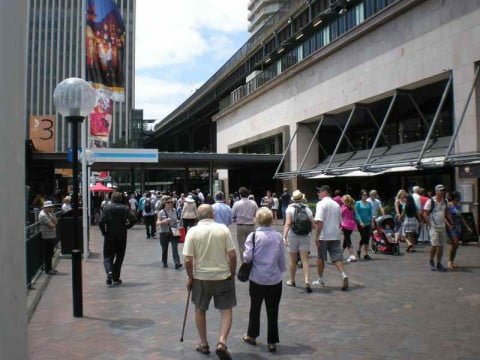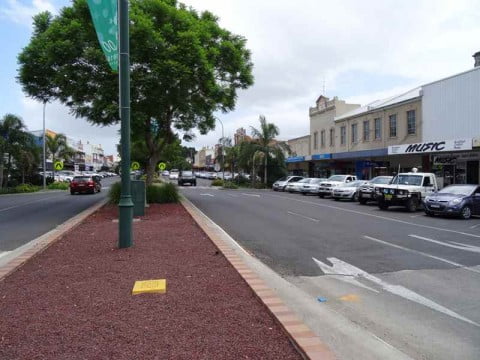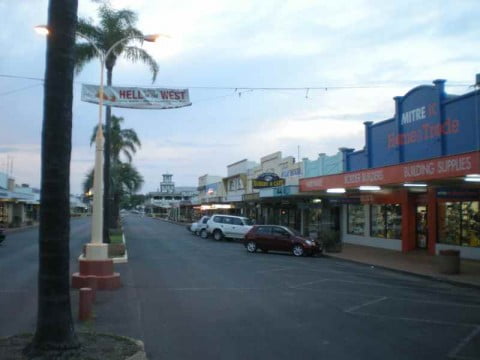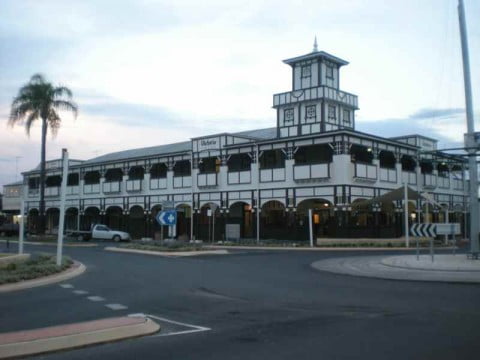I’ve often wondered what it would really be like to live in a small town in Australia. And when it comes to small towns, Australia’s got plenty of them. Most people who migrate to Australia though, they head for one of the big cities with Melbourne, Brisbane, Perth and the very busy Sydney topping the list…
 But as I said in a recent post, There’s more to Australia than Sydney, Melbourne, Brisbane and Perth.
But as I said in a recent post, There’s more to Australia than Sydney, Melbourne, Brisbane and Perth.
I have driven through plenty of smaller towns here in Australia, stopped off at quite a few of them as well to have a good look around. For example, this is Grafton in New South Wales, it has a population of about 18,000…



 This is Goondiwindi, a border town just in Queensland but close to New South Wales. It has a population of around 6000…
This is Goondiwindi, a border town just in Queensland but close to New South Wales. It has a population of around 6000…

 I’ve also driven through plenty of towns that have a population of less than 1000 people, most notably during our Australian road trip.
I’ve also driven through plenty of towns that have a population of less than 1000 people, most notably during our Australian road trip.
So, why am I mentioning all this now?
Because it turns out that people who live in these smaller towns are significantly happier than those living in our major cities. And how do I know this?
Hilda
You’ve met Hilda before, here she is again…
 Hilda is an acronym for Household, Income and Labour Dynamics in Australia. They have been conducting surveys each year in Australia since 2001. You can read much more about Hilda in my post called The Cost of Living “Comfortably” in Australia.
Hilda is an acronym for Household, Income and Labour Dynamics in Australia. They have been conducting surveys each year in Australia since 2001. You can read much more about Hilda in my post called The Cost of Living “Comfortably” in Australia.
Happiness
In the latest report out last week, they talked about life satisfaction and how it is affected by where you live. They divided locations in Australia into three categories by population density:
- Major urban = population of 100,000+
- Other urban = population of 1000 – 99,999
- Other region = population of under 1000 and rural and remote areas
They measured people’s satisfaction with their locations and they found that there were no significant differences across the states and territories other than, for some reason, a noticeably positive effect of living in Queensland for females.
Well, that’s nice for Mrs Bob.
But they did find population density to be a very important factor for both males and females. Specifically…
‘Towns smaller than 1,000 people and non-urban areas increase life satisfaction the most, closely followed by urban areas outside the major cities. Thus, other things being equal, the major cities are the least desirable places to live.‘
Positive proof that there really is more to Australia than our major cities.
For some people coming here on work-related visas, I believe it can sometimes be the case where they only qualify if they choose to go to a regional or rural area, that is to say not one of the major cities.
Sometimes that is seen as a negative, maybe it is not so bad after all.
What else did I find interesting in this report?
Schools
- 62.9% of high school students attend a free government school
- 21.3% of high school students attend a fee charging Catholic school
- 13.7% of high school students attend a fee charging ‘other’ non-government school
Is it worth paying for education?
- 49.1% of those attending a free government school will definitely or probably go to university, that rises to 74.3% for Catholic schools and 77.3% for ‘other’ non-government schools
- 21.7% of those attending a free government school say they get bullied at school, that drops to 15.2% at Catholic schools and 11.1% for ‘other’ non-government schools
So the answer is, definitely or probably, to use their own terminology.
Food shopping
The household weekly expenditure on food as at December 2012 prices was:
- For a couple = $205.47
- A couple with dependents = $279.24
- A lone person = $140.50
- An elderly couple = $182.40
This is a fascinating report with almost 100 pages; it really does have some very interesting information. It is not always easy to understand the data they are presenting, unless of course you have a natural understanding for quintiles and SEIFA indexes.
I don’t.
But Roger Wilkins of the Melbourne Institute of Applied Economic and Social Research in The University of Melbourne does and if you want to read the full report, you can directly download the PDF here.
I’m sure this will not be the last time we hear from Hilda.






what are the happiest cities in the world or australia?
I am reliably informed (Google) that the happiest city in the world is Copenhagen in Denmark, and the happiest place in Australia is Mayo in South Australia. No, I haven’t heard of it either.
I really have thought about leaving my country because of some really ridiculous things my government does and social issues that I feel I can no longer tolerate. Then I see statistics about other places and realize that leaving would not change anything. Who wants to send their kids to a school where they have a 50/50 chance of being bullied when they are supposed to be their to get educated? Overall though you do make Australia sound like a really nice place.
50/50? I think you need to check the article again, it’s 21.7% at worst, dropping to 11%.
Hilda sounds very interesting Bob. I have downloaded the report and can’t wait to go through it.
We decided to settle down out of a major city and I am really happy with our decision.
The people seem less stress and more helpful. And rental or buying property is so much more affordable.
Yes, most people I hear from or speak to who live in smaller towns seem very happy there, glad you have settled down in one as well.